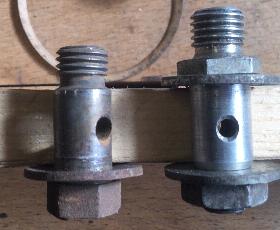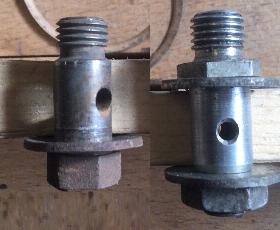The MGA With An Attitude
BANJO BOLT For Float Chamber, Change of Design - CB-111A
If you encounter a fuel leak at the float chamber mounting banjo bolt, the first suspect is deteriorated rubber grommets. A few years ago Moss Motors began making these grommets with Viton (which is much more fuel resistant than most other elastomers), and these hold their integrity a LOT longer.
If installing new grommets does not stop the leak, check the steel washer on the bottom of the stack. See illustrations below. For the 1500 model this is part number AUC1137. For very early 1600's the part number is AUC2130. I have no idea why the part number changed, but this should be a spherical washer (cup washer), and it MUST be installed with the concave side up. If someone installed it upside down or used a flat washer, it will leak. There is a shoulder on the bolt (early) or stud with nut (later). Pull it up until you contact the shoulder (tight). The float chamber should wiggle just a little with a firm push, otherwise quite firm and very secure.

Part numbers on the left come from the MGA 1500 SPL.
Part numbers on the right come from the MGA 1600 SPL.
Engine change point is not recorded, but apparently sometime during early 1600 production. I don't know why part numbers for the banjo bolt, old style cup washer and rubber grommet changed between 1500 and 1600 books. Float chambers and throttle bodies are the same with same female thread for the fuel port, so these banjo parts should be interchangeable as sets.
The bolt and stud will have the same top end thread, maybe slightly longer on the stud to accommodate the AUC1384 fiber seal washer. The bolt and stud will have the same barrel diameter to accept the same rubber grommets. The AUC1389 washer takes up a little space on the barrel of the stud; the AUC1137 (or AUC 2130) cup washer takes up similar space on the barrel of the bolt. As such the barrels should be about the same length.
AUC1389 washer (used with the stud) should probably be flat, as it takes the place of the flat face on the throttle body to back up the top grommet. This will have the same ID and OD as the earlier cup washer.
AUC1388 washer will have smaller ID than the cup washer, because it fits over the thread and bears against the shoulder on the stud. I would have expected this to be a cup washer similar to the earlier one, but it is actually flat, in which case the barrel of the stud may be slightly shorter than the shoulder on the bolt.
As a practical matter, when you need to replace the rubber grommets it may be easier to R&R the nut leaving the stud in place, although I have never had any problem to R&R the banjo bolt. The real difference is that multiple R&R of the bolt may eventually wear the threads or shoulder seating area on the pot metal throttle body.
As a casual observation, use of the stud will lower the float chamber assembly by thickness of the brass seal washer plus hex shoulder on the stud plus thickness of the top steel washer (about 1/8 inch total). This will effectively lower the fuel level relative to the main jet. This may be some of the reason why the 1600 and 1622 engines use different fuel metering needle than the 1500.
These images are found in the Burlen SU carburetor spare parts web page.


 There is an error here. The banjo bolt illustrated in "ALT 1" is incorrect shape. If you click on the detail number in the Burlen parts list it will show the correct part.
There is an error here. The banjo bolt illustrated in "ALT 1" is incorrect shape. If you click on the detail number in the Burlen parts list it will show the correct part.
The factory Service Parts List for MGA makes no mention of the "rigid" mount illustrated here as "Standard". The "Alt 1" configuration was installed on most MGA 1500, with "Alt 2" being used on all later MGA. The switch over point may have been around January 1959 production. The rigid mount is reported to be found on some of the CKD cars assembled in Australia. This may have been original issue, or may have been retrofit (as yet undetermined).
Addendum, April 14, 2021:
Here we have pictures of the two different banjo bolts side by side for comparison. Photo on left shows them with the banjo shoulders at same height. Photo on right has been split with the bolt raised higher relative to the stud to put the top mounting shoulders at same height. This is the way they are installed in the car, using the same throttle bodies for 1500 and 1600 type set-ups. This shows more clearly the difference in mounting height for the float chambers. This difference in fuel chamber height is likely the primary reason why the 1500 and 1600 engines have different fuel metering needles.


|



 There is an error here. The banjo bolt illustrated in "ALT 1" is incorrect shape. If you click on the detail number in the Burlen parts list it will show the correct part.
There is an error here. The banjo bolt illustrated in "ALT 1" is incorrect shape. If you click on the detail number in the Burlen parts list it will show the correct part. 
